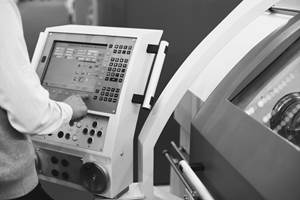The Dial Tells It All
Dial indicators—you've seen one, you've seen them all. They are all over the shop, and as you walk around, they all look the same to you.
Dial indicators—you've seen one, you've seen them all. They are all over the shop, and as you walk around, they all look the same to you.
But step closer and take a long look, because we are going to examine the indicator dial in detail. No, we are not going to go inside. We are going to look at the way the indicator presents information to the user—on the dial. There are different styles of dials, and the type is determined by how the indicator is used.
Indicator dials come in two basic formats: balanced and continuous. Whether to use one or the other is very often determined by the gage and the range of the indicator. However, in general, if the tolerances are bilateral, such as ± 0.001 inch, the balanced dial is preferred. If the tolerance is unilateral such as -0.000 to +0.002 inch, a continuous dial would be the preference.
Some dial indicators are sold with a very limited range, so limited that the dial only displays one revolution of measuring range. These one-rev indicators with balance dials are designed for high magnification and to eliminate miscounting the number of revolutions the hand of the indicator travels.
Because the dial indicator is often used on a handheld gage, such as a bore gage or snap gage, the mechanical travel of the gage is really the limiting factor in the measuring range. Therefore, there is no need for the dial indicator to have long range. And, since most tolerances are bilateral, the most common dial is the balance type.
Revolution counters are used on balanced dial indicators, even though they might have only two revolutions of total travel. This is because the hand may move so fast that the eye can't keep up. A balanced dial might indicate +0.010 inch when in reality, the hand has made an additional revolution and the actual measurement is +0.110 inch. In such cases, the rev-counter is a safeguard for assuring the correct reading.
But what if that dial indicator is now mounted to a test stand or a hand gage, such as a portable thickness gage? The dial indicator is now in a gage that can measure by comparison, or if the range is long enough, it could even be used as a direct measuring gage.
In the comparison mode, the dial would be of the balance type, but we have to start watching out for how many times the hand revolves and keep track of this number. Otherwise, we could make significant measurement errors and be off by a complete revolution of the dial.
This is where the rev-counter adds a degree of safety to the result. By reading a combination of the rev-counter and the dial, a proper result can be obtained.
When the indicator is used to make a direct measurement from the reference surface, the rev-counter, in conjunction with a continuous dial, is an absolute necessity. Some long-range indicators can have 10 or more revolutions, which would be too hard to try to count and remember as the hand went around.
The result of the measurement is the number of revolutions plus the amount read on the continuous dial. But of course, you have to know how much one revolution is worth.
For example, in the photograph at right, the revolution counter shows two revolutions of the hand, or 0.200 inch, and the big hand has come to rest at the 15 main dial division, or 0.015 inch. The sum of the two readings is 0.215 inch.
Some dial indicators have more then one rev-counter because they may travel more then ten revolutions of the dial. In these cases, each rev-counter is marked with its range, and the measurement is simply the sum of the three dial readings. In such cases, it is pretty simple to take the sum of each indictor for your total reading.
Very often we take the indicator we use for granted—but take a moment and examine the indicator dial. You'll see there's a reason it looks the way it does.
Related Content
Help Operators Understand Sizing Adjustments
Even when CNCs are equipped with automatic post-process gaging systems, there are always a few important adjustments that must be done manually. Don’t take operators understanding these adjustments for granted.
Read MoreChoosing the Correct Gage Type for Groove Inspection
Grooves play a critical functional role for seal rings and retainer rings, so good gaging practices are a must.
Read More6 Machine Shop Essentials to Stay Competitive
If you want to streamline production and be competitive in the industry, you will need far more than a standard three-axis CNC mill or two-axis CNC lathe and a few measuring tools.
Read MoreOrthopedic Event Discusses Manufacturing Strategies
At the seminar, representatives from multiple companies discussed strategies for making orthopedic devices accurately and efficiently.
Read MoreRead Next
5 Rules of Thumb for Buying CNC Machine Tools
Use these tips to carefully plan your machine tool purchases and to avoid regretting your decision later.
Read MoreRego-Fix’s Center for Machining Excellence Promotes Collaboration
The new space includes a showroom, office spaces and an auditorium that will enhance its work with its technical partners.
Read MoreRegistration Now Open for the Precision Machining Technology Show (PMTS) 2025
The precision machining industry’s premier event returns to Cleveland, OH, April 1-3.
Read More












.jpg;maxWidth=300;quality=90)









